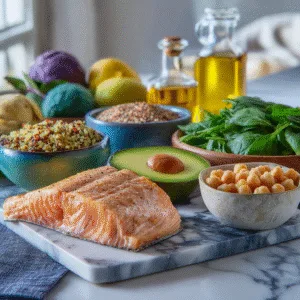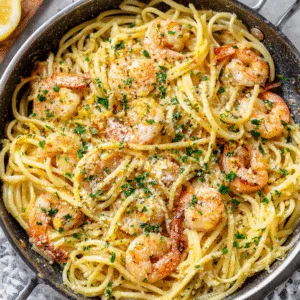Finding the right foods to eat while on semaglutide can feel confusing, especially when you’re trying to reduce side effects and stay on track with your goals. That’s where semaglutide recipes come in—balanced meals designed to support GLP-1 users with high protein, low sugar, and gut-friendly ingredients. In this guide, we’re diving into easy, flavorful ideas that nourish your body without overwhelming it. From breakfast to dinner (and even snacks for nausea days), you’ll find real, sustainable meal ideas. Let’s explore how to eat well, feel better, and enjoy food again—one GLP-1-friendly bite at a time.
Table of Contents
Table of Contents
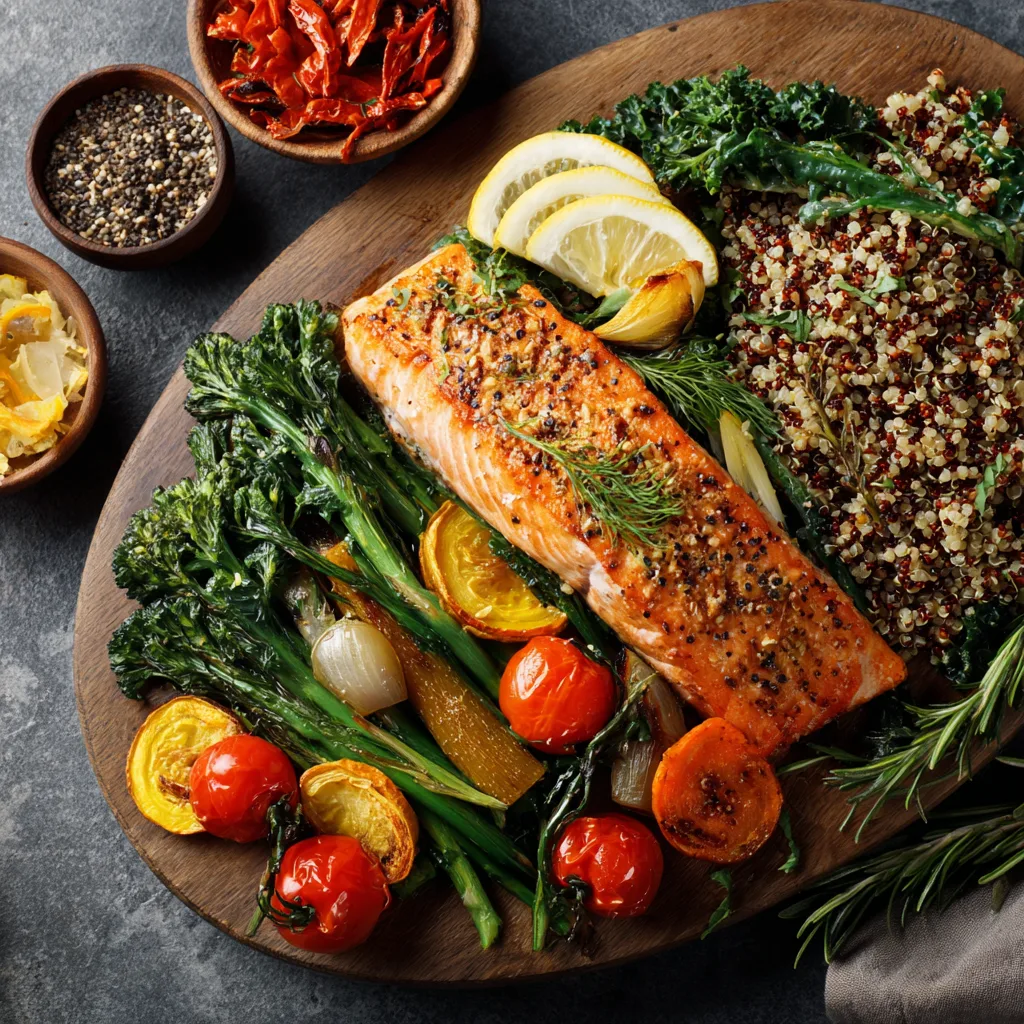
The Story Behind These Semaglutide Recipes
Why Real, Nourishing Meals Matter on a GLP-1 Journey
I remember the day I first heard about semaglutide. A close friend had started using it for weight management, and over coffee, she whispered, “I don’t know what to eat anymore.” That stuck with me. As someone who’s spent a lifetime learning that food is both fuel and comfort, I knew right then that folks needed more than just a medication—they needed real, supportive meals. That’s how I began exploring semaglutide recipes.
Here in my cozy kitchen outside Asheville, where the breeze carries hints of mountain pine and roasting vegetables, I started experimenting. Not fancy meals—just good, balanced food that helped keep nausea low and energy up. Because let’s face it: when semaglutide messes with your appetite, eating becomes less about indulgence and more about intuition. You want light, nourishing dishes that feel good going down and leave you satisfied—not bloated or queasy.
So I focused on GLP-1 friendly recipes packed with lean protein, fiber, and gentle flavors. From warming soups to make on slower days, to bright bowls that pack in nutrients without overwhelming your stomach, these semaglutide recipes became staples not just for my friend—but for me too.
I didn’t grow up with medical charts or macros in mind. I grew up with flour-dusted countertops and meals that brought people together. That same heart goes into every recipe you’ll find here: easy-to-make, real-food dishes tailored for the semaglutide lifestyle. Whether you’re navigating side effects or just trying to build new habits, these recipes are here to nourish, not complicate.
And if you’re wondering where to start, we’ll walk through it all—breakfasts, lunches, dinners, snacks—with tips to make every bite count.
Print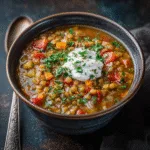
Semaglutide Recipes That Work: 7-Day GLP-1 Meal Plan to Feel Amazing
- Total Time: 40 minutes
- Yield: 4 servings 1x
- Diet: Vegetarian
Description
A nourishing, semaglutide-friendly soup packed with fiber, plant-based protein, and gentle flavors. Great for managing nausea while staying full.
Ingredients
- 1 tablespoon olive oil
- 1/2 cup chopped onion
- 2 cloves garlic, minced
- 2 medium carrots, diced
- 2 celery stalks, chopped
- 1/2 cup dry green or brown lentils (rinsed)
- 4 cups low-sodium vegetable broth
- 1 cup chopped spinach or kale
- 1/2 teaspoon turmeric
- Salt and pepper to taste
- Juice of 1/2 lemon
Instructions
- Heat olive oil in a large pot over medium heat.
- Add onion, garlic, carrots, and celery. Sauté for 5–6 minutes until softened.
- Stir in lentils and turmeric. Cook for 1 minute to toast spices.
- Pour in vegetable broth and bring to a boil.
- Reduce heat and simmer for 25–30 minutes, or until lentils are soft.
- Stir in spinach or kale. Simmer for 3–4 more minutes.
- Season with salt, pepper, and lemon juice to taste.
- Serve warm. Portion leftovers into containers for future meals.
Notes
You can use red lentils for a smoother texture.
Add a pinch of cumin or ginger for extra gut-soothing spice.
This soup freezes well in individual portions.
- Prep Time: 10 minutes
- Cook Time: 30 minutes
- Category: GLP-1 Recipes
- Method: Stovetop
- Cuisine: Comfort Food
Nutrition
- Serving Size: 1 bowl
- Calories: 185
- Sugar: 4g
- Sodium: 390mg
- Fat: 4g
- Saturated Fat: 0.5g
- Unsaturated Fat: 3.5g
- Trans Fat: 0g
- Carbohydrates: 29g
- Fiber: 8g
- Protein: 10g
- Cholesterol: 0mg
Smart Eating for Semaglutide Success
Balancing Protein, Fiber, and Healthy Fats
When you’re using semaglutide, what you eat matters just as much as when and how you eat. The goal isn’t a restrictive diet—it’s smarter nourishment. That’s why these semaglutide recipes focus on a balance of lean protein, fiber, and healthy fats. Protein helps preserve muscle mass during weight loss, fiber supports digestion, and fats—especially from sources like avocado, olive oil, and nuts—keep you feeling full without overwhelming your stomach.
Start each meal with a protein base: think grilled chicken, lentils, tofu, or eggs. Add fiber-rich sides like roasted vegetables, quinoa, or leafy greens. These combinations not only stabilize blood sugar but also reduce the chance of bloating or GI discomfort. A good example? A quinoa and veggie bowl topped with salmon and a drizzle of tahini dressing—it’s gentle, satisfying, and GLP-1 friendly.
For breakfast, skip the pastries and go for a protein-packed start like egg muffins or a chia pudding. Want a quick fix? You’ll love this High Protein Oatmeal Guide that works well with most GLP-1 plans.
Foods That Can Trigger Side Effects
While semaglutide recipes focus on nourishment, it’s just as important to understand what can cause discomfort. Fatty fried foods, high-sugar treats, and processed snacks can spike blood sugar and trigger nausea. Carbonated drinks and alcohol are common culprits for bloating. Instead, aim for small, well-balanced meals and drink plenty of water throughout the day.
If you’re unsure where to begin, Stress Balancing Nutrition offers a solid list of foods to embrace and avoid. By building meals around whole ingredients and avoiding heavy sauces or fried fare, you’ll feel more in control—and enjoy your meals more.
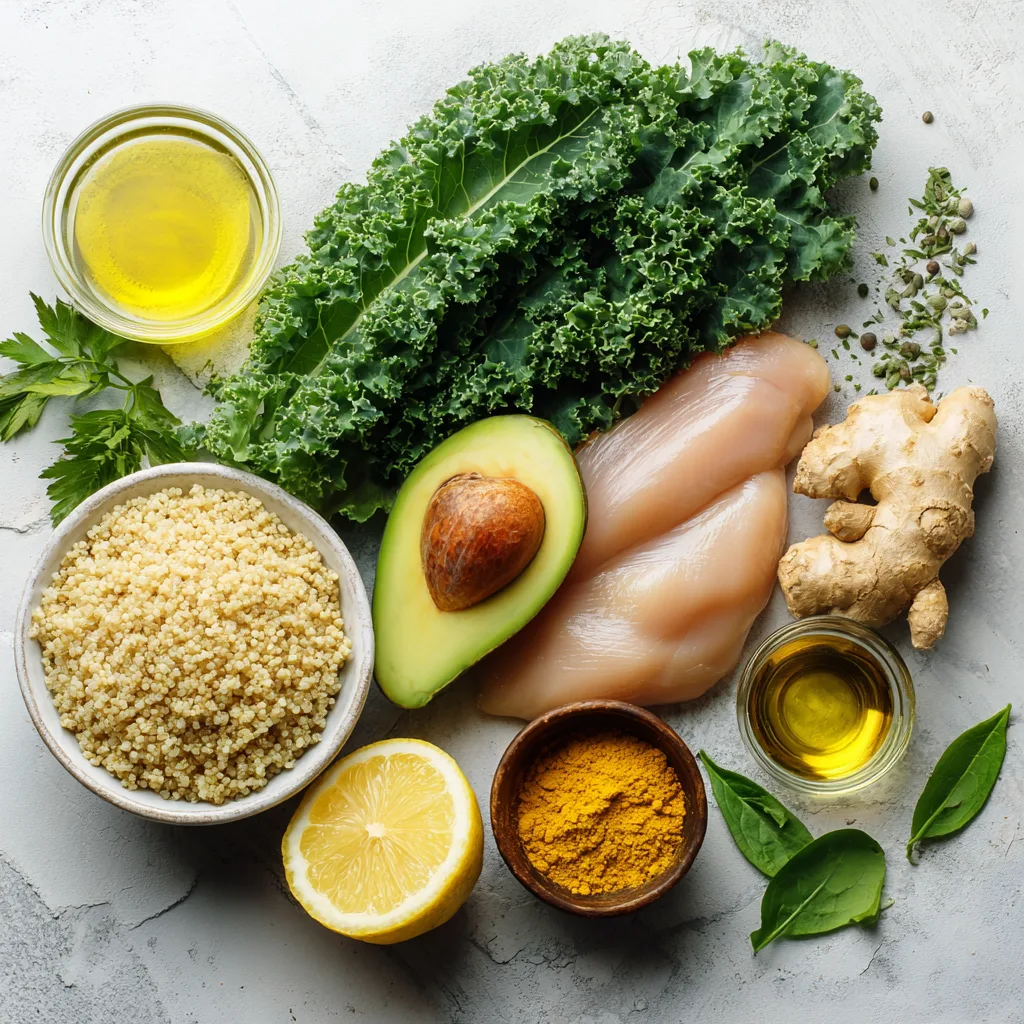
Timing Is Everything: Semaglutide Recipes That Fit Your Day
How to Eat Smaller Meals Without Losing Satisfaction
One of the biggest shifts when using semaglutide is how you feel hunger. Many users find their appetite significantly reduced, which can make traditional meal patterns uncomfortable or even counterproductive. That’s why portion control and timing are essential. These semaglutide recipes are designed to help you stay nourished with smaller, more frequent meals that don’t overwhelm your digestive system.
Instead of three large meals, aim for five to six mini-meals throughout the day. Each one should include a bit of protein and fiber to help stabilize your energy and reduce the chance of nausea.
Tips for Supporting Semaglutide with Smart Habits
Hydration is another often-overlooked piece of the puzzle. Semaglutide can slow gastric emptying, so drinking water between meals—rather than during—can help minimize bloating. Try sipping water 30 minutes before meals to support digestion, especially if you’re using oral semaglutide.
Timing also applies to when you eat in relation to your medication. Some users feel best when they eat about 30–60 minutes after their dose, especially in the morning. Test what works best for your body, and keep meals light early in the day if you notice nausea.
For a sample schedule that pairs perfectly with these timing strategies, check out our Ozempic Recipes: Amazing 7-Day Meal Plan .
Real Meals That Work: Semaglutide Recipes for Every Part of the Day
GLP-1 Friendly Breakfast, Lunch & Dinner Ideas
Building a sustainable routine with semaglutide recipes means starting with foods that fit your day and your appetite. Many users find they prefer light, protein-rich meals earlier in the day and more grounding options at dinner. That’s why variety matters.
Breakfast is about keeping things simple and protein-focused. Try a Protein Sparing Recipes or a batch of mini egg muffins packed with spinach and turkey. These meals are easy to prep, easy to digest, and give you a clean energy boost.
For lunch, think vibrant salads with lean protein or warming soups. One favorite? A chickpea and quinoa bowl with lemon vinaigrette—loaded with fiber, protein, and flavor.
Dinner is where things get comforting. Lean proteins like grilled salmon or baked tofu pair beautifully with roasted veggies or mashed cauliflower. A mild turkey chili is another great go-to, especially on cooler nights.
What to Eat When You’re Not Feeling Your Best
Not every day will feel the same. Some days, your appetite may vanish or nausea may kick in. That’s where gentler semaglutide recipes shine.
Blended soups, mashed sweet potatoes, and soft scrambled eggs can be soothing options.
On tough days, these soft, easy-to-digest meals help keep your nutrition on track without upsetting your stomach. Explore our full High-Protein Low-Carb Bowl for more gentle options.
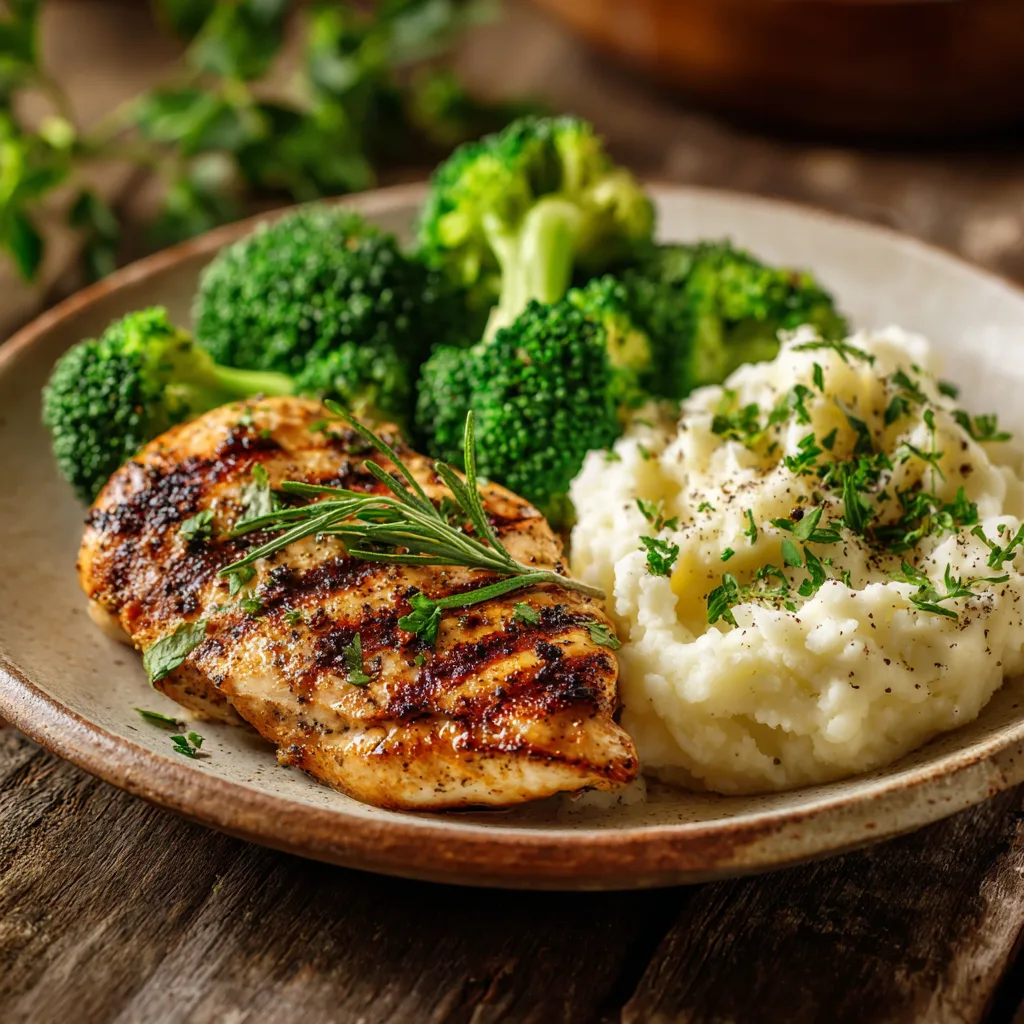
Your 7-Day Semaglutide Recipes Meal Plan
A Balanced Week of GLP-1 Friendly Meals
One of the biggest challenges with semaglutide is knowing what to eat and when. This 7-day meal plan takes the guesswork out of your week. It’s filled with semaglutide recipes that are protein-rich, fiber-filled, and easy on your stomach. Whether you’re managing nausea or just want structured support, this plan offers flexible, real-life meal ideas you’ll actually enjoy eating.
Each day follows the same basic structure: a light, protein-packed breakfast, a veggie-rich lunch, a comforting but clean dinner, and two simple snacks. You’ll see ingredient overlap to simplify prep and reduce waste—ideal for batch cooking or meal prepping on Sundays.
Simple and Sustainable Meals
Here’s what one day looks like on the plan:
- Breakfast: Greek yogurt with chia seeds, sliced strawberries, and slivered almonds
- Snack: One boiled egg with a few carrot sticks
- Lunch: Grilled chicken over mixed greens with avocado, cucumbers, and olive oil dressing
- Snack: Low-sugar protein shake or a rice cake with almond butter
- Dinner: Lentil and veggie soup with a side of roasted broccoli
Each day varies slightly but follows this rhythm to help manage hunger, support digestion, and minimize side effects.
Vegetarian or Pescatarian?Flexible Adjustments for Any Lifestyle
This meal plan isn’t one-size-fits-all. If you prefer plant-based options, swap in tofu, lentils, or tempeh for meat-based proteins. Fish lovers can enjoy baked salmon or tuna salads. Check out our 21-Day Meal Prep Challenge for more alternatives tailored to your lifestyle.
Cooking for Success: Easy Prep Tips for Semaglutide Recipes
Batch Cooking That Supports Your Routine
If semaglutide helps you manage your appetite, then smart prep helps you manage your week. Many people using semaglutide recipes find success by cooking once and eating multiple times. Batch cooking not only saves time, it also reduces the temptation to grab something that might trigger nausea or derail your progress.
Start by choosing a few core recipes that refrigerate or freeze well. Soups, roasted vegetables, quinoa, and grilled chicken are great examples. Make large batches and portion them into individual containers. Then, mix and match during the week. For instance, a batch of High Protein Meal Prep can be paired with cauliflower mash one day and tossed into a veggie soup the next.
Using airtight containers is key—so is labeling. Write the prep date and what’s inside. And if you’re freezing portions, be sure to thaw overnight in the fridge, not on the counter.
Low-Stress Cooking Hacks That Work
Flavor doesn’t have to come from heavy sauces or fried toppings. In fact, one of the best things you can do with semaglutide recipes is simplify. Lean into herbs like basil, parsley, or mint. Use spices like cumin, turmeric, and smoked paprika to build warmth without overloading your stomach.
Avoid strong, greasy aromas that might trigger nausea. Instead, roast vegetables in olive oil with sea salt and fresh lemon juice. It’s gentle but flavorful.
Looking for ingredient swap ideas? Our Protein Sparing Recipes walks you through smarter substitutions—from full-fat dairy to almond-based or lactose-free options that are easier to digest.
Cooking should feel empowering, not overwhelming. Prep what you can, flavor wisely, and always listen to your body.
Feel Better with Food: Managing Semaglutide Side Effects Naturally
What to Eat When Nausea Hits
One of the most common complaints among semaglutide users is nausea—especially during the first few weeks. But the right foods can make a major difference. That’s where carefully crafted semaglutide recipes come in. They’re not just about macros; they’re about soothing your body when it feels out of balance.
When nausea strikes, skip high-fat or fried foods entirely. Stick with soft, bland, and warm meals. Think mashed sweet potatoes, scrambled eggs, or blended veggie soups. One favorite is a mild carrot and ginger soup that’s both calming and easy to digest.
Ginger, peppermint, and fennel can help ease an upset stomach. Try sipping herbal teas between meals and eating slowly in a relaxed environment. And always keep hydrated—dehydration can intensify side effects.
Tips to Support Digestion and Comfort
Fast eating or heavy meals can lead to bloating, cramping, or reflux—especially when you’re on GLP-1 medications. Instead, aim to eat slowly, chew thoroughly, and stop eating as soon as you feel full. That “full” signal may come sooner than you’re used to, so tuning into your body is key.
Using semaglutide recipes designed with digestion in mind helps a lot. Focus on meals that are low in fat, moderate in fiber, and not overly spicy.
You don’t have to suffer through side effects. With small adjustments and nourishing food, you can make your semaglutide journey a lot more comfortable—and a lot more sustainable.
FAQs – semaglutide recipes
What should you not mix with semaglutide?
Avoid mixing semaglutide with alcohol, high-fat meals, or sugary foods. These can worsen side effects like nausea and bloating. Greasy foods in particular may slow digestion even more and lead to discomfort. Instead, stick to clean, GLP-1 friendly meals like the semaglutide recipes shared in this guide. Also, talk to your doctor about any other medications or supplements you’re taking, as some may interact with semaglutide.
What is the fastest way to lose weight on semaglutide?
Pairing semaglutide with a high-protein, low-sugar diet and daily movement leads to the best results. Use semaglutide recipes that focus on lean proteins, fiber, and healthy fats to keep you full while staying in a calorie deficit. Remember, slow and steady weight loss is more sustainable—and safer—than trying to rush results.
What should you eat while on semaglutide?
Focus on whole, unprocessed foods. Build your meals around lean proteins (chicken, fish, tofu), non-starchy vegetables, and small portions of whole grains. Stay away from fried foods, added sugars, and carbonated drinks. Our curated semaglutide recipes follow this exact structure to help you feel nourished without discomfort.
How can I make the best out of semaglutide?
Success with semaglutide comes from consistency. Follow a structured eating plan, stay hydrated, move your body daily, and use recipes designed to minimize side effects. Try the Ozempic Recipes: Amazing 7-Day Meal Plan and prep in advance to avoid last-minute poor choices.
Why am I not losing weight on semaglutide?
Several reasons could be at play: inconsistent dosing, eating more than your body needs (even unintentionally), or lack of physical activity. Sometimes, side effects like nausea can cause people to skip meals, then overeat later. Tracking food intake and sticking to semaglutide recipes can help you stay on track and identify patterns that need adjusting.

